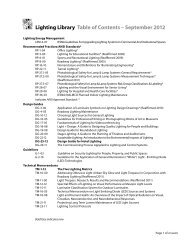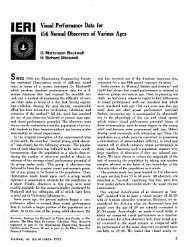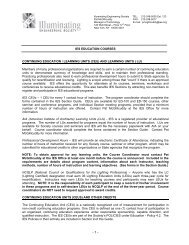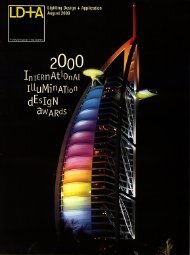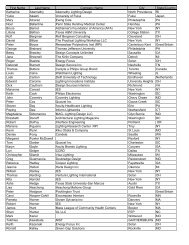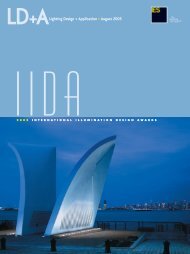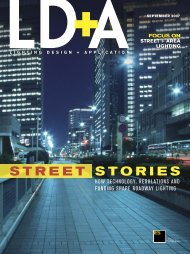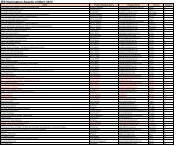light products - Illuminating Engineering Society
light products - Illuminating Engineering Society
light products - Illuminating Engineering Society
Create successful ePaper yourself
Turn your PDF publications into a flip-book with our unique Google optimized e-Paper software.
. . . . . . . . . . . . . . . . . . . . . . . . . . . . . . . . . . . . . . . . . . . . . . . . . . . . . . . . . . . . . .<br />
I I D A P R O J E C T<br />
at the ends of the ceiling panels where the<br />
dimension eventually approaches zero as the<br />
wing panel touches the flat ceiling. The last<br />
cove <strong>light</strong> fixture had to be separately dimmed<br />
to make the appropriate transition. The main<br />
trading floor incorporates two rows of concealed<br />
asymmetric distribution fluorescent<br />
cove <strong>light</strong>s mounted within the folded ceiling<br />
panels. High output T5 lamps were used in<br />
small optical assemblies.<br />
Additional recessed ceramic metal halide<br />
lamps were used to provide the direct <strong>light</strong>ing<br />
component. The ceramic metal halide lamps<br />
were used for their good color and reasonably<br />
long lamp life. To complete the three-dimensional<br />
modeling of the ceiling, semi-recessed wallmounted<br />
compact fluorescent up<strong>light</strong>s were<br />
used at the edges of the room. These fixtures illuminated<br />
the underside of the ceiling panels. The<br />
combination of these three <strong>light</strong>ing components<br />
provided up to 45 footcandles, glare free.<br />
A preset dimming system was designed to<br />
control all of the trading area <strong>light</strong>ing systems,<br />
maximize day<strong>light</strong> harvesting and time-of-day<br />
scheduling. The dimming system also controlled<br />
all of the automated shade systems and the all of<br />
the non-dimmed <strong>light</strong>ing loads throughout the<br />
facility. The integrated control system allowed us<br />
to easily commission the entire project in one<br />
day and one evening. The system also benefits<br />
users, allowing them full command from one<br />
point of control, and provides significant energy<br />
savings through time-of-day control, in addition<br />
to the day<strong>light</strong> harvesting.<br />
Making Use of Day<strong>light</strong><br />
The second challenge was to assess the effectiveness<br />
of all of the fenestrations for what we<br />
call “useable” day<strong>light</strong>ing. Traders have a reputation<br />
for wanting to work in a dark room.<br />
They’re jokingly called “vampires” because of<br />
their sensitivity to <strong>light</strong>. This reputation comes<br />
from years of exposure to bad <strong>light</strong>ing equipment<br />
and designs used in conjunction with bad<br />
monitors and trading turrets. Today’s monitors<br />
are much more tolerant of ambient <strong>light</strong> than<br />
those used five years ago. The <strong>light</strong>ing systems<br />
do not have to be designed around reflections<br />
in monitors any longer.<br />
Extensive day<strong>light</strong>ing studies were performed<br />
to evaluate the extent of useable day<strong>light</strong> and to<br />
develop a day<strong>light</strong> control strategy for all of the<br />
fenestrations. Each fenestration was assessed<br />
for sky brightness and direct sun. A solar tracking<br />
diagram was created to develop appropriate<br />
shielding elements for each fenestration. The<br />
shades on the north wall were angled 23 deg<br />
from true north to accommodate the buildings<br />
orientation. Each of the clerestories had individually<br />
controlled shades. All of the shades were<br />
designed to have 40 percent transmission to<br />
Ceiling panels contain<br />
indirect <strong>light</strong>ing and<br />
recessed down<strong>light</strong>ing to<br />
provide up to<br />
45 footcandles, glare-free.<br />
Traders have a reputation<br />
for wanting to work in a<br />
dark room. They’re jokingly<br />
called ‘vampires’ because of<br />
their sensitivity to <strong>light</strong><br />
reduce exposure. Blackout shades were considered<br />
but deemed unnecessary.<br />
This trading floor optimized the available day<strong>light</strong>.<br />
Automated shades were designed to track<br />
the sun and to only allow diffuse day<strong>light</strong> into<br />
the room. The electric <strong>light</strong>s are either dimmed<br />
or turned off when not required. The 50-ft tall<br />
north wall of glass also had automated shades<br />
to provide protection from excessive sky brightness,<br />
which occurred early in the morning<br />
throughout the year and at varying times during<br />
the work day. During commissioning of the<br />
<strong>light</strong>ing and shades, designers established a<br />
time of day when the shades should rise, should<br />
they be down because of sky brightness conditions.<br />
When the 4:00 bell rang that signifies the<br />
close of the markets, the shades would rise.<br />
That great idea only lasted a few days. The<br />
December 2005 LD+A 49




